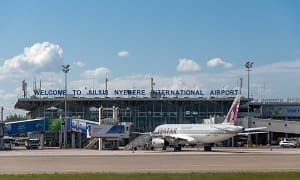Large South African retailers in East Africa are looking to the air freight industry for a rapid transport solution, writes Tristan Wiggill.
There is simply no faster way to import South African-made goods into East African destinations like Dar es Salaam than by aeroplane, and this is becoming the preferred method of South African retailers operating abroad. There was a time when South African Airways (SAA) flew dedicated cargo planes into East Africa – i.e. to Dar es Salaam – but it decided to terminate this service several years ago due to insufficient demand. You would need to fill a plane with 80% of passengers or 80% with cargo, most of the time, for it to become a viable route. Currently, passenger flights are being used to carry cargo in the bellies of these aeroplanes, via O.R. Tambo in Johannesburg. Rwandair flies to Dar es Salaam via Kigali and Kilimanjaro, while struggling Kenya Airways flies to Kilimanjaro. Ethiopian Airlines has just recommenced thrice weekly flights directly to King Shaka International Airport from Addis Ababa and is making use of the Dube Tradeport. One might assume that only perishable/time-sensitive goods are being air freighted from South Africa to East Africa, due to the costs involved, but the reality is that various types of freight are being flown. Machinery, foodstuffs, car spares, clothing and some pharmaceutical products are flown from South Africa to Dar es Salaam. In recent times, the clothing industry has seen increased export volumes to East African destinations as South African companies Mr Price and Woolworths’ retail stores, in places like Uganda, gain traction in the market. Zanzibar remains a popular tourist destination for South Africans, with the hotel industry requiring catering equipment from South African suppliers. Mango Airlines flies directly to touristy Zanzibar, as does fastjet, albeit with a 30-minute stopover in Dar es Salaam on the way. SAA flies twice daily to East Africa, while Kenya Airways, fastjet and Rwandair fly once daily from South Africa. Imports from East Africa are infrequent, but may comprise limited quantities of fresh produce from time to time. “A major problem for airlines on this route is the abundance of spare capacity, especially on the return leg to South Africa,” explains Vincent Banda, CEO of BidAir Cargo. “This situation renders the use of dedicated freighter aircraft unnecessary, which is exactly what is required to develop the South Africa-East Africa air freight industry.” The general state of the world economy means that fewer people are traveling and, so, passenger numbers in aircraft continue to decrease. There are also many interruptions in aviation services in Africa, and duties and clearance procedures are both costly (as much as $1 000 can be imposed on cargo owners for a single item weighing a few kilograms) and, by global standards, is quite inefficient. Richard Bodin, chief commercial officer at fastjet, whose commercial planes take off in Johannesburg and land in Tanzania daily, says passenger traffic on the route is increasing. There has also been an upturn in freight volume, although not in the traditional bulk freight sense. “We designed a product for informal traders, not the traditional freight customer, to get their goods to wholesale markets from Harare. By decoupling ticket prices, we allow traders to carry 80kg of goods at a cost of $18.This has proven to be popular as the journey from Harare to Dar es Salaam by bus can take three-and-a-half days, if you’re lucky, and does not take into account border delays.” The Johannesburg-Tanzania route is used to freight mining machinery, equipment and supplies and small quantities of fresh produce and flowers as well as goods that are not readily available in Tanzania. Low-cost pan-African carriers, like fastjet, are not as heavily impacted by the economic downturn as normal carriers, who are forced to reduce their ticket prices in an attempt to stop the bleeding.Bodin says the pan-African carrier is pushing against numerous barriers in its quest to link more countries on the continent. It has set up new bases in Zimbabwe and Zambia and is getting the necessary aircraft in place.
“There is a lot of bureaucracy and protectionism in the aviation industry in Africa and authorities deny granting permission to operate, even to those airlines that meet all regulatory and safety requirements. We want to democratise air travel and show how Tanzania has benefited by opening its doors to trade. Private companies are expressing more interest in the services we offer and there is a growing recognition that intra-regional trade in Africa is a fundamental requirement.” Freshly grounded Over the next five years, Dube Tradeport will focus its attentions on covering sub-Saharan Africa. The facility currently offers flights to Harare and Lusaka, but wishes to expand this. It offers alternatives to South African companies active in the rest of Africa. With so many of the countries in the region landlocked, moving goods by road means border post delays and deteriorating road infrastructure, which adds to supply chain costs. Dube Tradeport is a place to generate, process and transport cargo and give access to international markets. Many of the major freight forwarders in Durban who are involved in the air freight business are housed at Dube Tradeport, including the likes of Kuhne Nagel, and Bidvest Panalpina, among others. A bridge has been incorporated to deal with high volumes of cargo and there is a drive to get as many companies as possible to be located there. The intention is to look at high-value, low-weight products as it’s different to the port environment where bulky goods like sugar and citrus are imported and exported. It’s really there to provide a growing platform for people that cut flowers, berries and herbs and other low-weight, high-value products that have limited shelf-lives and need to be transported quickly to preserve shelf-life and quality. As an exporter, transport cost is reduced because it is possible to harvest in the morning and get the products onto an Emirates flight that leaves in the afternoon, meaning shelf-life is extended and the cold chain is unbroken. There is a lot of value-adding involved in that centre. The cargo terminal has four aircraft stands; there’s a freighter that’s based there that just carries cargo. Dube Tradeport is working hard to attract dedicated cargo carriers. The idea of the tradeport is to offer a platform to companies that are involved in processing, value adding and distribution of products. Agricultural goods are received from all over the province and beyond. The tradeport is involved in staging where certain products, like bananas, are kept and ripened in its facilities. In so doing, it ensures rapid response to the market.







